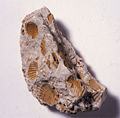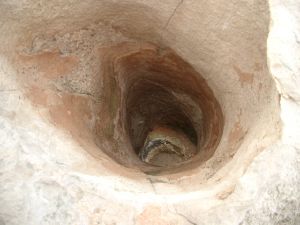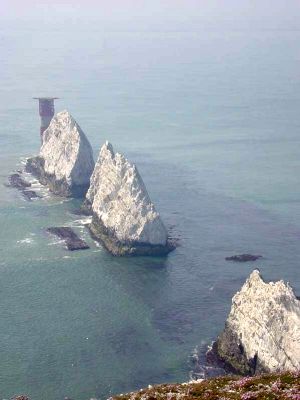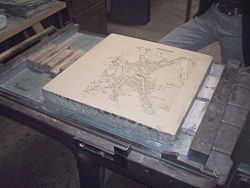Difference between revisions of "Limestone" - New World Encyclopedia
(moved text) |
|||
| Line 4: | Line 4: | ||
The calcite in limestone is produced mainly by [[marine biology|marine organisms]], many of which secrete shells that settle out of the water column and are deposited on [[ocean]] floors. Moreover, coral reefs are made from the calcium carbonate skeletons of coral-building organisms. Secondary calcite may be precipitated from [[groundwater]]* and deposited in caves, producing formations such as [[stalagmite]]*s and [[stalactite]]*s. | The calcite in limestone is produced mainly by [[marine biology|marine organisms]], many of which secrete shells that settle out of the water column and are deposited on [[ocean]] floors. Moreover, coral reefs are made from the calcium carbonate skeletons of coral-building organisms. Secondary calcite may be precipitated from [[groundwater]]* and deposited in caves, producing formations such as [[stalagmite]]*s and [[stalactite]]*s. | ||
| − | |||
| − | |||
| − | |||
| − | |||
<gallery> | <gallery> | ||
| Line 24: | Line 20: | ||
Bands of limestone emerge from the [[Earth]]'s surface in often spectacular rocky outcrops and [[island]]s. Examples include the Burren in Co. Clare, Ireland; the [[Verdon Gorge]]* in [[France]]; [[Malham Cove]]* in [[North Yorkshire]]*, [[England]]; on [[Fårö]]*, near the Swedish island of [[Gotland]]*; the [[Niagara Escarpment]]* bordering [[Canada]] and the [[United States]], Notch Peak in [[Utah]]*, and the [[Ha Long Bay]]* National Park in [[Vietnam]]. In addition, Belgium and Holland have several huge quarries, with a total gallery length of more than a hundred kilometers. An example of a hill with a lot of quarries is Mount Saint Peter (in the Belgium-Netherlands region) [http://www.pietersberg.nl]. | Bands of limestone emerge from the [[Earth]]'s surface in often spectacular rocky outcrops and [[island]]s. Examples include the Burren in Co. Clare, Ireland; the [[Verdon Gorge]]* in [[France]]; [[Malham Cove]]* in [[North Yorkshire]]*, [[England]]; on [[Fårö]]*, near the Swedish island of [[Gotland]]*; the [[Niagara Escarpment]]* bordering [[Canada]] and the [[United States]], Notch Peak in [[Utah]]*, and the [[Ha Long Bay]]* National Park in [[Vietnam]]. In addition, Belgium and Holland have several huge quarries, with a total gallery length of more than a hundred kilometers. An example of a hill with a lot of quarries is Mount Saint Peter (in the Belgium-Netherlands region) [http://www.pietersberg.nl]. | ||
| − | == Chalk == | + | == Varieties of limestone == |
| + | |||
| + | Limestone can be found in many varieties, depending on its mineral composition and physical structure. When composed of calcium carbonate alone, it is white or nearly white. Other colors are produced by the presence of minor constituents such as [[clay]], sand, organic remains, [[iron oxide]]*, and other materials. In addition, limestone may be crystalline, clastic, granular, or massive, depending on the method of formation. Crystals of calcite, [[quartz]]*, [[dolomite]]*, or [[barite]]* may line small cavities in the rock. | ||
| + | |||
| + | [[Travertine]] is a banded, compact variety of limestone formed along streams, particularly where there are waterfalls, and around [[Hot spring|hot]] or cold springs. Calcium carbonate is deposited upon evaporation of the water. [[Tufa]]*, a porous or cellular variety of travertine, is found near waterfalls. [[Coquina]]* is a poorly consolidated limestone composed of pieces of [[coral]] or [[Animal shell|shell]]s. During [[Rock (geology)|regional metamorphism]] that occurs during the mountain-building process (orogeny), limestone recrystallizes into [[marble]]. | ||
| + | |||
| + | === Chalk === | ||
[[Image:Dscn0646-needles 600x800.jpg|thumb|[[The Needles]], part of the extensive [[Southern England Chalk Formation]]]] | [[Image:Dscn0646-needles 600x800.jpg|thumb|[[The Needles]], part of the extensive [[Southern England Chalk Formation]]]] | ||
| Line 33: | Line 35: | ||
Because chalk is porous, chalk downland usually holds a large body of [[groundwater]], providing a natural reservoir that releases water slowly through dry seasons. The [[Somme River#Hydrology|River Somme]]* in northern [[France]] is an example of such water release from chalk. | Because chalk is porous, chalk downland usually holds a large body of [[groundwater]], providing a natural reservoir that releases water slowly through dry seasons. The [[Somme River#Hydrology|River Somme]]* in northern [[France]] is an example of such water release from chalk. | ||
| − | Chalk has been quarried from prehistory, providing building material and | + | Chalk has been quarried from prehistory, providing building material and soil conditioner for fields. The [[Chalk Formation]]* is a [[Europe]]an stratigraphic unit dating from the upper [[Cretaceous]] period. It includes the famous white cliffs of Dover of [[Kent]]*, [[England]], which are formed entirely of chalk deposits. The [[Champagne region]]* of [[France]] is mostly on chalk formations, with caves being carved out beneath the hills. |
| − | |||
| − | |||
| − | |||
| − | |||
| − | |||
| − | |||
| − | |||
| − | |||
| − | |||
| − | |||
| − | |||
| − | |||
| − | |||
| − | |||
| − | |||
| − | |||
| − | |||
| − | |||
| − | |||
| − | |||
== Uses of limestone == | == Uses of limestone == | ||
| Line 66: | Line 48: | ||
Today, limestone is used in the manufacture of [[cement]]*, [[Mortar (masonry)|mortar]]*, [[quicklime]]* (calcium oxide), and [[slaked lime]]* (calcium hydroxide). In addition, crushed limestone is useful in constructing the solid base for many roads, and pulverized limestone is used as a soil conditioner to neutralize acidic soil conditions. [[Geological formation]]*s of limestone are among the best [[petroleum]] reservoirs. | Today, limestone is used in the manufacture of [[cement]]*, [[Mortar (masonry)|mortar]]*, [[quicklime]]* (calcium oxide), and [[slaked lime]]* (calcium hydroxide). In addition, crushed limestone is useful in constructing the solid base for many roads, and pulverized limestone is used as a soil conditioner to neutralize acidic soil conditions. [[Geological formation]]*s of limestone are among the best [[petroleum]] reservoirs. | ||
| − | Purified, powdered chalk serves as a filler and pigment in paints, paper, ceramics, and plastics. It should be noted that the chalk used for blackboards is currently made of gypsum (calcium sulfate) rather than calcium carbonate. Also, for such | + | Purified, powdered chalk serves as a filler and pigment in paints, paper, ceramics, and plastics. It should be noted that the chalk used for blackboards is currently made of gypsum (calcium sulfate) rather than calcium carbonate. Also, for such activities as gymnastics, rock climbing, and weight lifting, the chalk applied to the hands usually consists of magnesium carbonate. |
== See also == | == See also == | ||
| Line 84: | Line 66: | ||
[[Category:Earth sciences]] | [[Category:Earth sciences]] | ||
| − | {{ | + | {{credit2|Limestone|70842763|Chalk|66227447}} |
Revision as of 01:13, 24 August 2006
Limestone is a sedimentary rock composed largely of the mineral calcite (calcium carbonate, CaCO3). It makes up about 10 percent of the total volume of all sedimentary rocks. Limestones often contain variable amounts of silica in the form of chert or flint, as well as varying amounts of clay, silt, and sand as disseminations, nodules, or layers within the rock.
The calcite in limestone is produced mainly by marine organisms, many of which secrete shells that settle out of the water column and are deposited on ocean floors. Moreover, coral reefs are made from the calcium carbonate skeletons of coral-building organisms. Secondary calcite may be precipitated from groundwater and deposited in caves, producing formations such as stalagmites and stalactites.
Limestone landscapes
Limestone is partially soluble, especially in acidic water, and therefore forms many landforms produced by erosion. These include limestone pavements (horizontal surfaces of exposed limestone), caves, gorges, potholes, and cenotes (limestone sinkholes filled with freshwater). Such erosion landscapes, usually marked by underground drainages, are known as "karsts."
Limestone is less resistant to erosion than most igneous rocks, but more resistant than most other sedimentary rocks. Limestone is therefore usually associated with hills and occurs in regions with other sedimentary rocks, typically clays.
Bands of limestone emerge from the Earth's surface in often spectacular rocky outcrops and islands. Examples include the Burren in Co. Clare, Ireland; the Verdon Gorge in France; Malham Cove in North Yorkshire, England; on Fårö, near the Swedish island of Gotland; the Niagara Escarpment bordering Canada and the United States, Notch Peak in Utah, and the Ha Long Bay National Park in Vietnam. In addition, Belgium and Holland have several huge quarries, with a total gallery length of more than a hundred kilometers. An example of a hill with a lot of quarries is Mount Saint Peter (in the Belgium-Netherlands region) [1].
Varieties of limestone
Limestone can be found in many varieties, depending on its mineral composition and physical structure. When composed of calcium carbonate alone, it is white or nearly white. Other colors are produced by the presence of minor constituents such as clay, sand, organic remains, iron oxide, and other materials. In addition, limestone may be crystalline, clastic, granular, or massive, depending on the method of formation. Crystals of calcite, quartz, dolomite, or barite may line small cavities in the rock.
Travertine is a banded, compact variety of limestone formed along streams, particularly where there are waterfalls, and around hot or cold springs. Calcium carbonate is deposited upon evaporation of the water. Tufa, a porous or cellular variety of travertine, is found near waterfalls. Coquina is a poorly consolidated limestone composed of pieces of coral or shells. During regional metamorphism that occurs during the mountain-building process (orogeny), limestone recrystallizes into marble.
Chalk
Chalk is a soft, white, porous form of limestone. It is relatively resistant to erosion and slumping, compared to the clays with which it is usually associated. Consequently, it forms tall, steep cliffs where chalk ridges meet the sea. Chalk hills, known as chalk downland, usually form where bands of chalk reach the surface at an angle.
Chalk is formed in shallow waters by the gradual accumulation of the calcite mineral remains of microorganisms, over millions of years. Chalk beds commonly have embedded flint nodules.
Because chalk is porous, chalk downland usually holds a large body of groundwater, providing a natural reservoir that releases water slowly through dry seasons. The River Somme in northern France is an example of such water release from chalk.
Chalk has been quarried from prehistory, providing building material and soil conditioner for fields. The Chalk Formation is a European stratigraphic unit dating from the upper Cretaceous period. It includes the famous white cliffs of Dover of Kent, England, which are formed entirely of chalk deposits. The Champagne region of France is mostly on chalk formations, with caves being carved out beneath the hills.
Uses of limestone
Limestone is readily available and relatively easy to cut into blocks or carve elaborately. It is also long-lasting and stands up well to exposure. It is therefore popular in architecture and has been used to make many landmarks around the world, especially in Europe and North America. In the United States, Indiana has long been noted as a source of high-quality, quarried building limestone, while many famous buildings in London are built from Portland limestone.
Many medieval churches and castles in Europe are made of limestone. In the late nineteenth and early twentieth centuries, many train stations, banks, and other structures were made of limestone. Kingston, Ontario, Canada, has so many buildings constructed from limestone that the place was nicknamed "Limestone City." In recent years, thin limestone plates have been used as a facade on some skyscrapers.
On the other hand, limestone is a very heavy material, making it impractical for tall buildings. It is also quite expensive. A more significant problem is that limestone and marble are very reactive to acidic solutions, such as acid rain. Many limestone statues and building surfaces have suffered severe damage from acid rain.
Today, limestone is used in the manufacture of cement, mortar, quicklime (calcium oxide), and slaked lime (calcium hydroxide). In addition, crushed limestone is useful in constructing the solid base for many roads, and pulverized limestone is used as a soil conditioner to neutralize acidic soil conditions. Geological formations of limestone are among the best petroleum reservoirs.
Purified, powdered chalk serves as a filler and pigment in paints, paper, ceramics, and plastics. It should be noted that the chalk used for blackboards is currently made of gypsum (calcium sulfate) rather than calcium carbonate. Also, for such activities as gymnastics, rock climbing, and weight lifting, the chalk applied to the hands usually consists of magnesium carbonate.
See also
- Rock (geology)
- Marble
- Mineral
- Quarry
External links
Credits
New World Encyclopedia writers and editors rewrote and completed the Wikipedia article in accordance with New World Encyclopedia standards. This article abides by terms of the Creative Commons CC-by-sa 3.0 License (CC-by-sa), which may be used and disseminated with proper attribution. Credit is due under the terms of this license that can reference both the New World Encyclopedia contributors and the selfless volunteer contributors of the Wikimedia Foundation. To cite this article click here for a list of acceptable citing formats.The history of earlier contributions by wikipedians is accessible to researchers here:
The history of this article since it was imported to New World Encyclopedia:
Note: Some restrictions may apply to use of individual images which are separately licensed.






